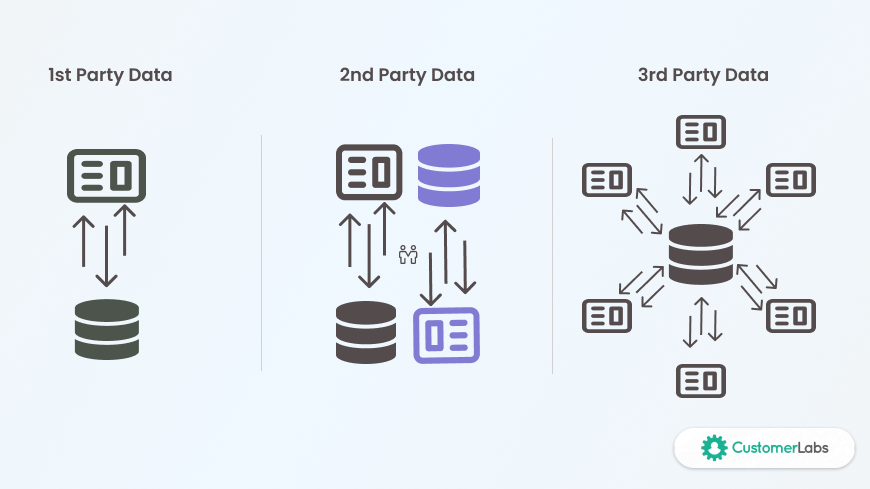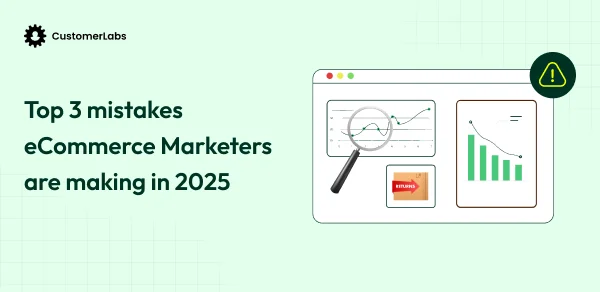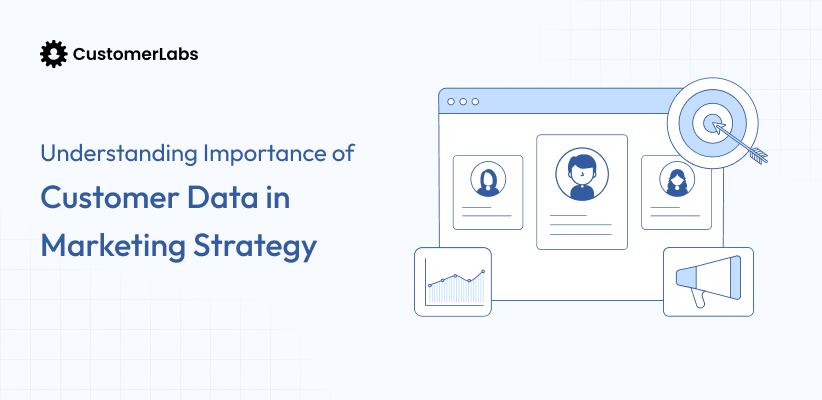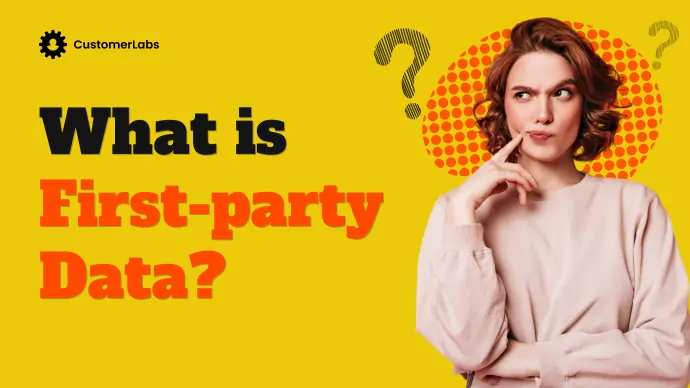First-party data, second-party data, third-party data, zero-party data.
What do they actually mean? How are they different from each other? And which is the trustworthy amongst the data that I can rely on? Wait, I remember a movie dialogue

“You can’t trust anyone these days; you have to do everything yourself.” from The Dark Knight
This line should be ringing in your head right now. (Remember this dialogue; I will come it later in the blog.)
That’s the sole purpose of this blog. I will provide you with information on the types of data, how they are collected, and what you should probably rely on for your marketing success. Let’s keep rolling then.
Know The Data Types – First-Party Data, Second-Party Data, Third-Party Data, Zero-Party Data
Let’s break down every data type in detail

First-Party Data
First-party data: it is your data.
First-party data is collected directly from your customers or users via any source (website, app, or offline interactions) and it is reliable.
Since it is collected directly from your own customers with explicit consent, it is super privacy-compliant. For instance, first-party data includes website or app interactions, offline purchases, customer email ID, phone number, addresses, surveys, page views, ad clicks and many more.
You can collect them from sources such as online (website, app, ads) and offline (CRM, in-store purchase data). In recent times, marketers are rapidly shifting to relying on first-party data to enhance their marketing campaigns.
First-party data is not just limited to customer data but also business data such as profits, stock level, and business location, etc. As it is collected directly from internal systems, it belongs to you and can be used to utilize operations, improve personalization and make data-driven decisions.
The one shortcoming with first-party data is the implementation or a proper setup. It can be a huge and bit overwhelming process since the data is collected from multiple sources. But incorporating effective tools like 1PD Ops to collect, unify, segment and activate your customer data in the easiest way possible.
Do read on: How 1PD Ops is the key to activating your customer data in 2025.
Second-Party Data
Second-party data: it is their data
This data is owned by someone and shared with you for your marketing needs. Second-party data is basically other brands first-party data, which is shared with you through partnership agreements. This might be the case when you have the same set of target audience members who might be interested in your product or services as well.
Second-party data is somewhat reliable because it is not collected from your own customers, aka, not owned by you. And it also helps to expand audience insights. For example, a travel website shares its data with the hotel chains, or like a sportswear brand partnering with a fitness app.
How is this data collected? Through mutual data-sharing agreements between businesses, direct partnerships with complementary brands, or programmatic ad deals where publishers share audience data.
For example, a fitness app will share workout and diet preferences user data with a healthy meal delivery service through a mutual data-sharing agreement. The meal service brand will use this second-party data to target health-conscious users with personalized meal plans.
Some marketers still leverage second-party data, but it’s no longer a viable data strategy. With stricter privacy laws, rising data costs, and the decline of third-party cookies, relying on borrowed data is becoming less effective. While it can compliment a strategy, it lacks the control, accuracy, and long-term value.
Third-Party Data
Third-party data: it is not your data or their data; it is somebody’s data.
This is cumulative data collected from multiple sources and sold to businesses for audience targeting. Third-party data is often collected without direct user consent, making it less reliable.
Meta Pixel and third-party cookies have been widely used to track user behavior across websites without direct user consent, and they also get blocked by ad blockers. This has led to reduced ad efficiency, rising costs, and a decline in accurate attribution. Marketers who once depended on third-party data are now struggling to track customer journeys effectively.
To provide you with some examples of third-party data: audience segments purchased from data brokers like Acxiom or Experian or purchasing behavioral data from ad networks.
Third-party data is purchased or shared from data brokers, ad platforms, and web cookie tracking, who compile information from various online and offline sources.
The practice of using third-party data is now long dead. If you are still relying on third-party data, it’s time to wake up now and follow a working data strategy.
Zero-Party Data
Zero-party data: It’s not just your data—it’s your customers speaking to you directly.
Data that is shared explicitly by your customers or users with full consent is zero-party data. It is high-intent and highly reliable data since it comes directly from users who voluntarily provide their preferences.
Meaning? Like customers sharing their skin concerns, types and treatment preferences with a customized skincare brand. What they share is zero-party data.
It is collected just like first-party data, from surveys on websites or apps, polls, feedback forms, and subscription sign-up forms asking for content or product preferences.
You can build hyperpersonalized marketing campaigns without breaking the privacy laws.
Now, you should be clear about what the types of data are and how it is collected. In the next section, let’s explore which data you should reply on and why.
Which Type of Data Should Marketers Rely On, and Why?
So let’s see which data is solid rock and what’s crumbling away.
Third-party is a Big NO
It was once a solid rock that you would have relied on, but now it’s a soft rock. If you stand on it, it will crush you along with it.
Along with that, privacy laws such as GDPR and CCPA brought in limitations on data sharing, which forced marketers like you to rethink and revise the marketing strategies.
For years, you have been relying on third-party data and might have seen successful campaigns. But unfortunately, third-party cookies have started disappearing (thanks to Google, Apple, and privacy-focused regulations), making audience tracking unreliable.
To top it off, ad platforms insist on controlling the data that you send across.
This has terribly affected the campaign’s efficiency. Without proper tracking of the user behavior, by which I mean missing out on critical data points—such as which products a user viewed, how they interacted with your site, or their purchase intent—campaign optimization suffers. You are made to increase your budget, this results in wasted ad spend, declining ROAS, and frustration for marketers who can’t pinpoint what’s working and what’s not.
If you are still relying on third-party data, just say a Big NO.
The second party is also a NO
Building your campaigns on someone’s ground is not wise, is it? Second-party data might seem like rock, but it won’t in the long run.
Since that is not your data, you don’t have an assurance on the quality of the data, and you never know when it will stop showing up. Once it stops showing up, your campaign, all the marketing strategies, and efforts will fall to the ground. (remember the movie dialogue, “You can’t trust anyone these days; you have to do everything yourself”, I said earlier?)
With second-party data, ad targeting will become ineffective and also expensive. Adding the spice of personalization through your campaigns is not possible. Even when you do, it might end up getting to the irrelevant users. You’ll have no control with the AI dominating the ad platforms and forever evolving.
Second-party data is not for the long-run
First-party data a Big Yes
First-party (1P) data is a solid rock; you can lay your marketing foundation on it.
Since the data is collected from your own users, data accuracy and reliability is extremely high. This means you are privacy complainant, respecting your users privacy and the privacy laws.
First-party data also assures no data loss, so the campaigns yield good conversions as the ad algorithms are fed in with high-quality data.
Personalization is made easy with higher conversion rates because, with first-party data, you can track all the touch points of the audiences very precisely. Platforms like Meta & Google allow brands to activate first-party data for audience targeting. Lookalike audiences and retargeting campaigns based on first-party data perform significantly better.
It’s time to accept first-party data with a Big Yesss
Zero-party data is also a Big Yes
A-class Rock. You can do wonders with it as you wish.
Zero-party data is also consented data, so no privacy laws are broken. This earns your users trust and builds loyalty towards your brand. You can develop and deploy trillions of marketing strategies based on this data.
You can setup hyperpersonalized campaigns, skyrocketing your ROAS. How? Your customers directly said what they are interested in, which means higher engagement rates and higher conversions. To give you an example, let’s take a brand that provides customized hair care treatments. The customer will share their details, like their hair type and issues that they want to address. Now, the brand can use this data to set hyperpersonalized campaigns with unique messaging, which will lead to conversions.
Essentially, zero-party data gives you the key to unlocking personalized experiences that drive results.
When zero-party data is combined with first-party data, you can create an unshakeable data foundation come what may.
Moving forward, let’s understand how you can use first-party data (a twin of Zero-party data) to strengthen your marketing strategies.
How Marketers Can Use First-Party Data?
Privacy-First Marketing & Compliance
Privacy laws are getting stricter day by day (not to mention the Meta’s recent event restrictions on health and wellness brands).
Collect customer interactions, purchases, and website events directly from your channels with consent, which reduces the risk of third-party dependence or hefty fines. First-party data is tracked via server-side tracking, where the data is sent securely to your own server, you can send this data to Meta to increase the event match rate and increased attribution accuracy.
Personalized Marketing & Customer Segmentation
Once you have collected your user data without any data loss, you can build personalized marketing campaigns. By segmenting your audience based on user behavior, gender, interests, purchase behaviour and as granular as you can.
Setting up campaigns for every specific audience segment with personalized messaging can improve your conversion rates effectively. You can also send these segmented user data to Meta for ad optimization for more accurate targeting.
Enhanced Customer Experience & Journey Mapping
With precise user data, you can track the entire customer journey from multiple touch points and understand the drop-off points and loopholes that hinder the users from getting converted. Tracking the entire customer journey will provide you with insights that might be crucial for the efficiency of your ad campaigns.
Predictive Analytics & Customer Lifetime Value (CLV) Optimization
With solid first-party data, you can take data-driven decisions on the ad spend. You can also enhance cross-channel attribution to understand which touchpoints drive the most revenue and focus on high-value customers, improving retention and lifetime value.
These are some of the ways in which you can use your first-party data.
Your own data is cool, right? But it can be hectic to handle or manage.
But there is always an easy way out there. Someone can collect your user data, store, unify, segment, activate and do many more things for you.
Turning First-Party Data into Revenue with 1PD Ops
Remember that movie dialogue in the beginning that I spoke about? You can’t trust anyone these days; you have to do everything yourself.” from The Dark Knight
You have to do it yourself.
Why do you need the 1PD Ops (First-Party Data Ops) platform? To streamline and fine-tune your first-party data. Your first-party data is collected from different sources: website, CRM, offline sales, surveys and so that data is everywhere. Without proper setup, you cannot use your data effectively.
You don’t have to build a setup from scratch. It’s already been done for you. 1PD Ops can collect your first-party data from different sources, unify and organize them with identity resolution, and activate them as valuable data that can be used for your marketing needs.
With 1PD Ops, you don’t just collect data—you turn it into revenue. Book your demo today.







